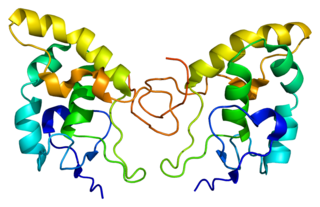Related Research Articles

Motilin receptor is a G protein-coupled receptor that binds motilin. Motilin in turn is an intestinal peptide that stimulates contraction of gut smooth muscle.
The testicular receptor proteins are members of the nuclear receptor family of intracellular transcription factors. There are two forms of the receptor, TR2 and TR4, each encode by a separate gene.

The nuclear receptor 4A2 (NR4A2) also known as nuclear receptor related 1 protein (NURR1) is a protein that in humans is encoded by the NR4A2 gene. NR4A2 is a member of the nuclear receptor family of intracellular transcription factors.

Leukotriene B4 receptor 1 is a protein that in humans is encoded by the LTB4R gene.

The G protein-coupled bile acid receptor 1 (GPBAR1) also known G-protein coupled receptor 19 (GPCR19), membrane-type receptor for bile acids (M-BAR) or TGR5 as is a protein that in humans is encoded by the GPBAR1 gene.

Proto-oncogene Wnt-1, or Proto-oncogene Int-1 homolog is a protein that in humans is encoded by the WNT1 gene.

Frizzled-5(Fz-5) is a protein that in humans is encoded by the FZD5 gene.

Frizzled-3(Fz-3) is a protein that in humans is encoded by the FZD3 gene.

Frizzled-8(Fz-8) is a protein that in humans is encoded by the FZD8 gene.

Frizzled-9(Fz-9) is a protein that in humans is encoded by the FZD9 gene. Fz-9 has also been designated as CD349.

Lysophosphatidic acid receptor 2 also known as LPA2 is a protein that in humans is encoded by the LPAR2 gene. LPA2 is a G protein-coupled receptor that binds the lipid signaling molecule lysophosphatidic acid (LPA).

Frizzled-10(Fz-10) is a protein that in humans is encoded by the FZD10 gene. Fz-10 has also been designated as CD350.

G-protein coupled receptor family C group 5 member B is a protein that in humans is encoded by the GPRC5B gene.

G-protein coupled receptor family C group 5 member C is a protein that in humans is encoded by the GPRC5C gene.

G-protein coupled receptor family C group 5 member D is a protein that in humans is encoded by the GPRC5D gene.

Retinoic acid-induced protein 3 is a protein that in humans is encoded by the GPRC5A gene. This gene and its encoded mRNA was first identified as a phorbol ester-induced gene, and named Phorbol Ester Induced Gen 1 (PEIG-1); two years later it was rediscovered as a retinoic acid-inducible gene, and named Retinoic Acid-Inducible Gene 1 (RAIG1). Its encoded protein was later named Retinoic acid-induced protein 3.

Frizzled-4(Fz-4) is a protein that in humans is encoded by the FZD4 gene. Fz-4 has also been designated as CD344.

G protein-coupled receptor family C group 6 member A (GPRC6A) is a protein that in humans is encoded by the GPRC6A gene. This protein functions as a receptor of L-α-amino acids, cations, osteocalcin, and steroids. It is a membrane androgen receptor.
The class C G-protein-coupled receptors are a class of G-protein coupled receptors that include the metabotropic glutamate receptors and several additional receptors.

Low-density lipoprotein receptor-related protein 6 is a protein that in humans is encoded by the LRP6 gene. LRP6 is a key component of the LRP5/LRP6/Frizzled co-receptor group that is involved in canonical Wnt pathway.
References
- ↑ Cheng Y, Lotan R (1998). "Molecular cloning and characterization of a novel retinoic acid-inducible gene that encodes a putative G protein-coupled receptor". J. Biol. Chem. 273 (52): 35008–15. doi: 10.1074/jbc.273.52.35008 . PMID 9857033.
- ↑ Bräuner-Osborne H, Krogsgaard-Larsen P (2000). "Sequence and expression pattern of a novel human orphan G-protein-coupled receptor, GPRC5B, a family C receptor with a short amino-terminal domain". Genomics. 65 (2): 121–8. doi:10.1006/geno.2000.6164. PMID 10783259.
- ↑ Robbins MJ, Michalovich D, Hill J, Calver AR, Medhurst AD, Gloger I, Sims M, Middlemiss DN, Pangalos MN (2000). "Molecular cloning and characterization of two novel retinoic acid-inducible orphan G-protein-coupled receptors (GPRC5B and GPRC5C)". Genomics. 67 (1): 8–18. doi:10.1006/geno.2000.6226. PMID 10945465.
- ↑ Bräuner-Osborne H, Jensen AA, Sheppard PO, Brodin B, Krogsgaard-Larsen P, O'Hara P (2001). "Cloning and characterization of a human orphan family C G-protein coupled receptor GPRC5D". Biochim. Biophys. Acta. 1518 (3): 237–48. doi:10.1016/s0167-4781(01)00197-x. PMID 11311935.
- ↑ Harada Y, Yokota C, Habas R, Slusarski DC, He X (2007). "Retinoic Acid-Inducible G Protein-Coupled Receptors Bind to Frizzled Receptors and May Activate Non-canonical Wnt Signaling". Biochem. Biophys. Res. Commun. 358 (4): 968–75. doi:10.1016/j.bbrc.2007.04.208. PMC 2854581 . PMID 17521608.